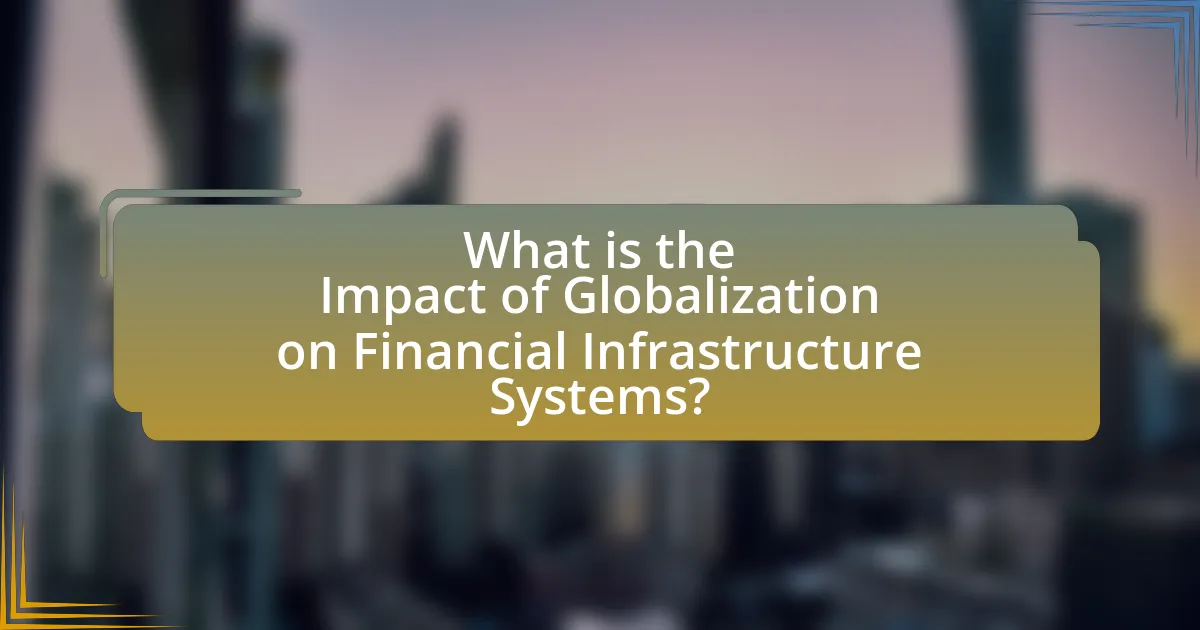The article examines the impact of globalization on financial infrastructure systems, highlighting how increased cross-border capital flows and market integration enhance access to international investment opportunities. It discusses key components affected by globalization, including payment systems, regulatory frameworks, and technological advancements, which collectively improve transaction efficiency and financial stability. The article also addresses challenges such as regulatory discrepancies and cybersecurity threats, while emphasizing the role of technology and international regulations in adapting financial systems to a globalized economy. Additionally, it explores future trends, including the rise of digital currencies and sustainable finance practices, which are shaping the evolution of financial infrastructure.

What is the Impact of Globalization on Financial Infrastructure Systems?
Globalization significantly enhances financial infrastructure systems by increasing cross-border capital flows and integrating financial markets. This integration allows for greater access to international investment opportunities, which can lead to improved liquidity and efficiency in financial transactions. For instance, according to the International Monetary Fund, global foreign direct investment reached approximately $1.5 trillion in 2020, demonstrating the scale of cross-border financial activities. Additionally, globalization fosters technological advancements in financial services, such as digital payment systems and blockchain technology, which streamline operations and reduce transaction costs. These developments collectively strengthen the resilience and adaptability of financial infrastructure systems in a rapidly changing global economy.
How does globalization influence financial infrastructure systems?
Globalization significantly influences financial infrastructure systems by enhancing cross-border transactions and integrating financial markets. This integration facilitates the flow of capital, allowing for increased investment opportunities and access to diverse financial products. For instance, the establishment of international payment systems, such as SWIFT, has streamlined global transactions, reducing costs and time associated with cross-border payments. Additionally, globalization has led to the adoption of standardized regulations and practices, which improve transparency and efficiency in financial operations. According to the International Monetary Fund, the globalization of finance has contributed to a 50% increase in global capital flows since the 1990s, underscoring its impact on financial infrastructure systems.
What are the key components of financial infrastructure systems affected by globalization?
The key components of financial infrastructure systems affected by globalization include payment systems, regulatory frameworks, financial markets, and information technology. Payment systems have evolved to facilitate cross-border transactions, enabling faster and more efficient transfers of funds internationally. Regulatory frameworks have been influenced by international standards, such as those set by the Financial Action Task Force, which aim to harmonize regulations across countries to combat money laundering and ensure financial stability. Financial markets have become interconnected, allowing for greater capital flows and investment opportunities, as evidenced by the rise of global stock exchanges and the integration of bond markets. Information technology has advanced significantly, with innovations like blockchain and digital currencies reshaping how financial transactions are conducted globally. These components collectively illustrate how globalization has transformed financial infrastructure systems, enhancing their complexity and interdependence.
How do these components interact within a global context?
The components of financial infrastructure systems interact within a global context through interconnected networks that facilitate cross-border transactions and regulatory compliance. These systems, including payment processing, banking regulations, and financial technologies, enable seamless international trade and investment by standardizing practices and ensuring security. For instance, the SWIFT network connects over 11,000 financial institutions worldwide, allowing for efficient communication and transaction processing, which is essential for global commerce. Additionally, the adoption of international standards, such as ISO 20022 for financial messaging, enhances interoperability among different systems, further integrating global financial markets. This interaction is evidenced by the increase in foreign direct investment, which reached approximately $1.5 trillion in 2020, highlighting the reliance on robust financial infrastructure to support globalization.
What are the historical developments of financial infrastructure systems in a globalized world?
The historical developments of financial infrastructure systems in a globalized world include the evolution of payment systems, the establishment of international financial institutions, and the integration of technology in finance. In the late 20th century, the rise of electronic payment systems, such as SWIFT in 1973, facilitated cross-border transactions, enhancing global trade. The establishment of institutions like the International Monetary Fund (IMF) in 1944 and the World Bank in 1944 provided frameworks for international financial stability and development. Additionally, the advent of the internet in the 1990s revolutionized financial services, leading to the emergence of online banking and fintech solutions, which further integrated global markets. These developments collectively transformed financial infrastructure, enabling faster, more efficient, and secure transactions on a global scale.
How has technology shaped the evolution of financial infrastructure systems?
Technology has significantly shaped the evolution of financial infrastructure systems by enabling real-time transactions, enhancing security, and facilitating global connectivity. The introduction of digital payment systems, such as blockchain and mobile banking, has transformed traditional banking operations, allowing for instantaneous fund transfers across borders. For instance, the adoption of blockchain technology has improved transaction transparency and reduced fraud, as evidenced by the increased use of cryptocurrencies in financial markets. Additionally, advancements in cybersecurity measures have strengthened the protection of sensitive financial data, which is crucial in an increasingly digital economy. Overall, technology has streamlined financial processes, making them more efficient and accessible on a global scale.
What role do international regulations play in the development of these systems?
International regulations are crucial in shaping the development of financial infrastructure systems by establishing standardized frameworks that promote stability, transparency, and interoperability across borders. These regulations, such as the Basel Accords, set minimum capital requirements and risk management standards for banks, which enhance the resilience of financial systems globally. Furthermore, international regulations facilitate cross-border transactions and investments by ensuring compliance with anti-money laundering (AML) and counter-terrorism financing (CTF) measures, thereby fostering trust among financial institutions. The implementation of these regulations has been shown to reduce systemic risks, as evidenced by the improved stability observed in financial markets following the adoption of such frameworks after the 2008 financial crisis.
What challenges do financial infrastructure systems face due to globalization?
Financial infrastructure systems face significant challenges due to globalization, primarily including regulatory discrepancies, cybersecurity threats, and increased competition. Regulatory discrepancies arise as different countries implement varying financial regulations, complicating compliance for multinational institutions. For instance, the Basel III framework, which aims to strengthen bank capital requirements, is not uniformly adopted, leading to inconsistencies in financial stability across borders. Cybersecurity threats have escalated as financial systems become interconnected, making them more vulnerable to attacks; the 2017 Equifax breach, which exposed sensitive data of 147 million people, exemplifies the risks involved. Increased competition from fintech companies, which often operate with fewer regulatory constraints, pressures traditional financial institutions to innovate rapidly or risk losing market share. These challenges collectively hinder the efficiency and security of financial infrastructure systems in a globalized economy.
How do economic disparities between countries impact financial infrastructure?
Economic disparities between countries significantly impact financial infrastructure by creating unequal access to financial services and resources. Wealthier nations typically possess advanced financial systems, including sophisticated banking networks and regulatory frameworks, which facilitate efficient capital flows and investment opportunities. In contrast, countries with lower economic status often struggle with underdeveloped financial infrastructures, characterized by limited banking services, inadequate regulatory oversight, and a lack of access to international markets.
For instance, according to the World Bank, as of 2021, only 30% of adults in low-income countries had access to formal financial services, compared to over 90% in high-income countries. This disparity hinders economic growth in poorer nations, as businesses face challenges in securing financing, leading to reduced investment and innovation. Furthermore, the lack of robust financial infrastructure in developing countries can increase vulnerability to economic shocks, as they are less able to absorb financial risks or attract foreign investment. Thus, economic disparities directly correlate with the effectiveness and reach of financial infrastructure, influencing overall economic stability and growth.
What risks are associated with the integration of global financial systems?
The integration of global financial systems poses several risks, including systemic risk, regulatory challenges, and increased vulnerability to financial contagion. Systemic risk arises when interconnected financial institutions can transmit shocks across borders, as evidenced during the 2008 financial crisis, where failures in one country led to widespread global repercussions. Regulatory challenges occur due to differing national regulations, which can create loopholes and inconsistencies, complicating oversight and compliance. Additionally, increased vulnerability to financial contagion is evident in how economic downturns in one region can rapidly affect markets worldwide, as seen during the Eurozone crisis, where instability in Greece impacted global markets.
How do financial infrastructure systems adapt to globalization?
Financial infrastructure systems adapt to globalization by enhancing interoperability, increasing regulatory compliance, and leveraging technology for efficiency. These systems integrate international standards, such as the ISO 20022 messaging standard, to facilitate cross-border transactions and improve communication between different financial entities. Additionally, they adopt advanced technologies like blockchain and artificial intelligence to streamline processes, reduce costs, and enhance security. For instance, the implementation of real-time gross settlement systems in various countries has enabled faster and more secure international payments, reflecting the need for speed and reliability in a globalized economy.
What strategies are employed to enhance resilience in financial infrastructure?
Strategies employed to enhance resilience in financial infrastructure include diversification, robust regulatory frameworks, and investment in technology. Diversification reduces systemic risk by spreading exposure across various asset classes and geographic regions, which mitigates the impact of localized economic shocks. Robust regulatory frameworks, such as those established by the Basel III standards, ensure that financial institutions maintain adequate capital buffers and liquidity, thereby enhancing stability during crises. Investment in technology, particularly in cybersecurity and data analytics, strengthens the ability to detect and respond to threats, ensuring continuity of operations. These strategies collectively contribute to a more resilient financial infrastructure capable of withstanding global economic fluctuations.
How do innovations in technology support adaptation to global changes?
Innovations in technology support adaptation to global changes by enhancing communication, improving data analysis, and facilitating efficient resource management. For instance, advancements in artificial intelligence and big data analytics enable organizations to predict market trends and consumer behavior, allowing them to respond swiftly to economic shifts. According to a report by McKinsey & Company, companies that leverage data-driven decision-making are 23 times more likely to acquire customers and 6 times more likely to retain them. Furthermore, technologies such as blockchain improve transparency and security in financial transactions, which is crucial for maintaining trust in a globalized economy. These technological innovations collectively empower businesses and governments to navigate and adapt to the complexities of global changes effectively.

What are the benefits of globalization for financial infrastructure systems?
Globalization enhances financial infrastructure systems by increasing efficiency, accessibility, and innovation. It allows for the integration of global markets, which facilitates cross-border transactions and reduces costs associated with currency exchange and international trade. For instance, the implementation of real-time payment systems, such as SWIFT and SEPA, has streamlined international payments, making them faster and more reliable. Additionally, globalization fosters competition among financial institutions, leading to improved services and technological advancements. According to the World Bank, countries that embrace globalization experience a 1.5% increase in GDP growth, highlighting the economic benefits tied to enhanced financial infrastructure.
How does globalization enhance efficiency in financial transactions?
Globalization enhances efficiency in financial transactions by facilitating faster cross-border payments and reducing transaction costs. The integration of global financial markets allows for real-time processing of transactions, which minimizes delays associated with currency conversion and regulatory compliance. For instance, the adoption of technologies such as blockchain and digital payment systems has streamlined processes, enabling instantaneous transfers and lowering fees. According to a report by the World Bank, the cost of remittances has decreased significantly due to globalization, with average fees dropping from 9% in 2000 to around 6% in 2021, demonstrating the tangible benefits of increased competition and innovation in the financial sector.
What technologies facilitate faster and more secure transactions globally?
Blockchain technology facilitates faster and more secure transactions globally by providing a decentralized ledger that enhances transparency and reduces fraud. This technology allows for real-time processing of transactions, significantly decreasing the time required for cross-border payments, which can take days using traditional banking systems. For instance, Ripple’s blockchain network enables transactions to be completed in seconds, compared to the typical 3-5 business days for international wire transfers. Additionally, the use of encryption and cryptographic techniques in blockchain ensures that transaction data is secure and tamper-proof, further enhancing security. According to a report by the World Economic Forum, blockchain could reduce the costs of cross-border payments by up to 80%, demonstrating its potential to transform global financial transactions.
How do global partnerships improve service delivery in financial systems?
Global partnerships enhance service delivery in financial systems by facilitating knowledge sharing, resource pooling, and technology transfer among institutions across different countries. These collaborations enable financial entities to adopt best practices and innovative solutions, leading to improved efficiency and customer service. For instance, the World Bank and International Monetary Fund often collaborate with local governments to implement financial reforms, which have been shown to increase access to financial services by up to 20% in developing regions. Such partnerships also help standardize regulations and practices, which can reduce transaction costs and improve the overall stability of financial systems globally.
What opportunities arise from globalization for financial institutions?
Globalization presents significant opportunities for financial institutions, primarily through expanded market access and increased capital flows. Financial institutions can tap into new customer bases across borders, enhancing their revenue potential. For instance, according to the International Monetary Fund, global cross-border capital flows reached approximately $12 trillion in 2021, indicating a vast landscape for investment and lending opportunities. Additionally, globalization facilitates the adoption of innovative financial technologies and practices, allowing institutions to improve efficiency and service delivery. The integration of global markets also enables risk diversification, as institutions can spread their investments across various regions, mitigating potential losses from localized economic downturns.
How can financial institutions leverage globalization for growth?
Financial institutions can leverage globalization for growth by expanding their operations into emerging markets, which allows them to access new customer bases and diversify their revenue streams. By entering these markets, institutions can benefit from increased demand for financial services, as evidenced by the rapid growth of banking sectors in countries like India and Brazil, where the financial services market is projected to grow significantly due to rising middle-class populations and increased digital banking adoption. Additionally, globalization enables financial institutions to optimize their operations through technology and innovation, enhancing efficiency and reducing costs, as seen in the rise of fintech companies that utilize global platforms to offer competitive services.
What new markets can be accessed through global financial infrastructure?
Global financial infrastructure enables access to emerging markets such as Southeast Asia, Africa, and Latin America. These regions are increasingly integrated into the global economy, driven by advancements in technology and regulatory frameworks that facilitate cross-border transactions. For instance, the World Bank reported that digital payment systems have significantly increased financial inclusion in countries like Kenya and Nigeria, allowing businesses and consumers to engage in international trade more effectively. Additionally, platforms like SWIFT and blockchain technology enhance transaction efficiency, further opening up these new markets for investment and commerce.

What are the future trends in financial infrastructure systems influenced by globalization?
Future trends in financial infrastructure systems influenced by globalization include increased digitalization, enhanced regulatory frameworks, and the rise of decentralized finance (DeFi). Digitalization is driven by the need for real-time transactions and cross-border payment solutions, with technologies like blockchain facilitating faster and more secure exchanges. Enhanced regulatory frameworks are emerging to address the complexities of global financial transactions, ensuring compliance and risk management across jurisdictions. The rise of DeFi represents a shift towards peer-to-peer financial services, reducing reliance on traditional banks and enabling greater financial inclusion. These trends are supported by the growing adoption of fintech solutions, which are reshaping how financial services are delivered globally.
How is digital currency impacting global financial infrastructure?
Digital currency is transforming global financial infrastructure by enhancing transaction speed, reducing costs, and increasing accessibility. Traditional banking systems often involve lengthy processes and high fees for cross-border transactions; however, digital currencies facilitate near-instantaneous transfers with minimal fees, as evidenced by the use of cryptocurrencies like Bitcoin and stablecoins in remittances. According to a report by the World Bank, the average cost of sending remittances globally was 6.5% in 2020, while digital currencies can lower this cost significantly. Furthermore, digital currencies promote financial inclusion by providing unbanked populations with access to financial services through mobile technology, as highlighted by the rise of decentralized finance (DeFi) platforms. This shift is reshaping how financial institutions operate, compelling them to adapt to a more digital-centric model.
What are the implications of blockchain technology for financial systems?
Blockchain technology fundamentally transforms financial systems by enhancing transparency, security, and efficiency. Its decentralized nature reduces reliance on intermediaries, thereby lowering transaction costs and increasing transaction speed. For instance, cross-border payments can be settled in minutes rather than days, as evidenced by Ripple’s blockchain solution, which facilitates real-time international transactions. Additionally, blockchain’s immutable ledger ensures that all transactions are recorded securely, minimizing fraud and enhancing trust among participants. According to a report by the World Economic Forum, blockchain could potentially reduce global banking infrastructure costs by up to $20 billion annually by streamlining processes and reducing fraud.
How do central bank digital currencies affect traditional financial infrastructure?
Central bank digital currencies (CBDCs) significantly impact traditional financial infrastructure by enhancing payment efficiency and reducing transaction costs. CBDCs streamline cross-border transactions, enabling faster settlements compared to conventional banking systems, which often involve multiple intermediaries and lengthy processing times. For instance, the Bank of International Settlements reported that CBDCs could reduce the cost of cross-border payments by up to 50%. Additionally, CBDCs can improve financial inclusion by providing unbanked populations access to digital financial services, thereby altering the landscape of traditional banking. This shift necessitates adaptations in existing financial systems, including regulatory frameworks and technological upgrades, to accommodate the integration of CBDCs into the broader financial ecosystem.
What role does sustainability play in the future of financial infrastructure systems?
Sustainability is crucial for the future of financial infrastructure systems as it drives the integration of environmentally responsible practices into financial operations. Financial institutions are increasingly adopting sustainable practices to mitigate risks associated with climate change, enhance their reputations, and meet regulatory requirements. For instance, the Global Sustainable Investment Alliance reported that global sustainable investment reached $35.3 trillion in 2020, reflecting a 15% increase over two years, indicating a growing trend towards sustainability in finance. This shift not only supports long-term economic stability but also aligns financial systems with global sustainability goals, such as the United Nations Sustainable Development Goals.
How can financial infrastructure systems support sustainable development goals?
Financial infrastructure systems can support sustainable development goals by facilitating access to capital, enhancing financial inclusion, and promoting transparency in financial transactions. These systems enable efficient allocation of resources, which is essential for funding projects that align with sustainability objectives, such as renewable energy and infrastructure development. For instance, the World Bank reports that improved financial infrastructure can increase access to finance for small and medium enterprises, which are crucial for job creation and economic growth, thereby contributing to Goal 8 of the Sustainable Development Goals. Additionally, robust financial systems can provide data and analytics that help track progress towards these goals, ensuring accountability and informed decision-making.
What practices are emerging to ensure environmentally responsible financial systems?
Emerging practices to ensure environmentally responsible financial systems include the integration of Environmental, Social, and Governance (ESG) criteria into investment decisions, the development of green bonds, and the implementation of sustainable finance frameworks. Financial institutions are increasingly adopting ESG criteria to assess risks and opportunities related to environmental sustainability, which has been shown to enhance long-term financial performance. The global green bond market reached approximately $1 trillion in issuance by 2021, indicating a significant shift towards financing projects that have positive environmental impacts. Additionally, regulatory bodies are promoting sustainable finance frameworks, such as the European Union’s Sustainable Finance Action Plan, which aims to redirect capital flows towards sustainable investments and mitigate climate change risks. These practices collectively contribute to the establishment of financial systems that prioritize environmental responsibility.
What best practices can be adopted for enhancing financial infrastructure in a globalized context?
To enhance financial infrastructure in a globalized context, adopting a multi-layered approach that includes regulatory harmonization, technological integration, and stakeholder collaboration is essential. Regulatory harmonization ensures that financial systems across different countries adhere to common standards, which facilitates cross-border transactions and reduces compliance costs. For instance, the Basel III framework provides a set of international banking regulations that enhance financial stability and transparency.
Technological integration, particularly through the adoption of blockchain and digital payment systems, can streamline processes and improve efficiency. According to a report by the World Economic Forum, blockchain technology can reduce transaction costs by up to 40% in cross-border payments.
Stakeholder collaboration among governments, financial institutions, and technology providers fosters innovation and addresses challenges collectively. The Financial Stability Board emphasizes the importance of public-private partnerships in developing resilient financial infrastructures that can adapt to global changes.
These best practices collectively contribute to a more robust and efficient financial infrastructure capable of supporting globalization.
How can collaboration between nations improve financial infrastructure resilience?
Collaboration between nations can significantly improve financial infrastructure resilience by enabling the sharing of best practices, resources, and technologies. When countries work together, they can develop standardized protocols and frameworks that enhance the stability and security of financial systems. For instance, joint initiatives like the Financial Stability Board promote international cooperation to address systemic risks, which can lead to more robust regulatory environments. Additionally, collaborative efforts in cybersecurity, such as information sharing on threats and vulnerabilities, can protect financial infrastructures from attacks. The World Bank’s Global Financial Development Report highlights that countries with strong international partnerships are better equipped to withstand financial shocks, demonstrating that collaboration directly contributes to enhanced resilience.
What are the key considerations for policymakers in developing robust financial systems?
Policymakers must prioritize regulatory frameworks, financial inclusion, and technological innovation when developing robust financial systems. Regulatory frameworks ensure stability and transparency, as seen in the Basel III standards, which were implemented to strengthen bank capital requirements and reduce systemic risk. Financial inclusion is critical, as approximately 1.7 billion adults globally remain unbanked, highlighting the need for accessible financial services to foster economic growth. Technological innovation, particularly in fintech, enhances efficiency and customer experience, evidenced by the rapid adoption of mobile banking solutions in developing countries. These considerations collectively contribute to the resilience and effectiveness of financial systems in a globalized economy.


